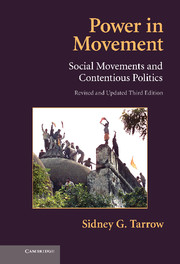Book contents
- Frontmatter
- Contents
- List of Figures
- List of Tables
- Preface
- Acknowledgments
- Introduction
- 1 Contentious Politics and Social Movements
- PART I THE BIRTH OF THE MODERN SOCIAL MOVEMENT
- PART II POWERS IN MOVEMENT
- PART III DYNAMICS OF CONTENTION
- Conclusions: The Future of Social Movements
- Sources
- Index
- Titles in the series
Introduction
- Frontmatter
- Contents
- List of Figures
- List of Tables
- Preface
- Acknowledgments
- Introduction
- 1 Contentious Politics and Social Movements
- PART I THE BIRTH OF THE MODERN SOCIAL MOVEMENT
- PART II POWERS IN MOVEMENT
- PART III DYNAMICS OF CONTENTION
- Conclusions: The Future of Social Movements
- Sources
- Index
- Titles in the series
Summary
On May 30th, 2010, six ships left Turkey and approached the coast of Israel/Palestine to deliver supplies to the coastal enclave of Gaza. Most of the ships were owned by a Turkish NGO called the IHH (İnsani Yardım Vakfi, or Foundation for Human Rights and Freedoms). On board were over 600 peace, humanitarian, and pro-Palestinian, anti-Israel activists determined to break the blockade with which, since 2007, Israel had been strangling the economy of Gaza. Approaching the coast, the flotilla was attacked from sea and air by an Israeli commando squadron. When the attack ended, nine activists lay dead or dying, and a number of Israeli commandos were wounded, some of them seriously.
How did this happen, and what does it have to do with “contentious politics”? In 2007, the Gaza Strip, a detached part of the Palestinian territories, was taken over from the more moderate Palestinian governmental party, Fatah, in a bloody coup by the radical Hamas group. From that point on, the Israeli army began to limit access to Gaza, both for fear of arms getting into the hands of Hamas militants, who had been attacking Israeli settlements, and to isolate Hamas, an Islamist group that continued to call for Israel's destruction. Those measures were not sufficient to prevent home-made missiles from killing Israelis living in towns near the border.
- Type
- Chapter
- Information
- Power in MovementSocial Movements and Contentious Politics, pp. 1 - 15Publisher: Cambridge University PressPrint publication year: 2011

